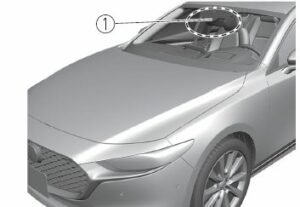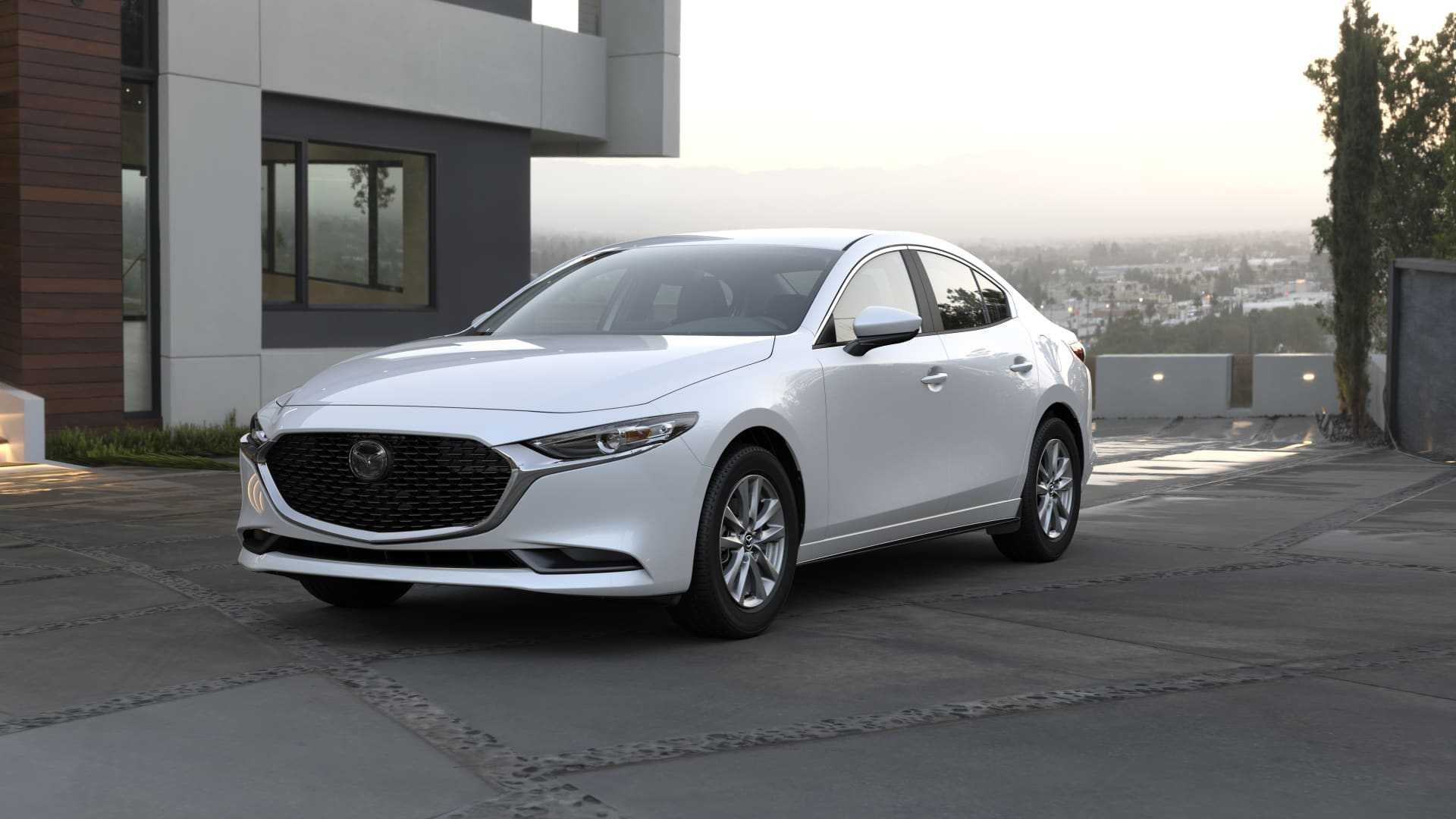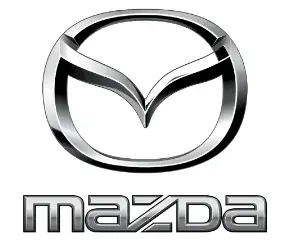Mazda 3 Sedan 2023 Forward Sensing Camera User Manual
Introduction
The Mazda 3 Sedan 2023’s forward sensing camera is a sophisticated system that employs advanced imaging technology to provide a variety of useful functions. This camera, which is discreetly located near the rearview mirror, captures real-time images of the road ahead, allowing the vehicle’s safety systems to make informed decisions and take appropriate actions. The forward sensing camera’s primary function is to assist the vehicle’s advanced driver-assistance systems (ADAS). Features such as lane-keeping assist, adaptive cruise control, and automatic emergency braking are included in these systems.
The Mazda 3 Sedan 2023’s forward sensing camera exemplifies the brand’s dedication to innovation and safety. Its advanced capabilities give drivers extra confidence and peace of mind, resulting in a safer and more enjoyable driving experience.
Forward Sensing Camera (FSC)
Forward Sensing Camera (FSC)
Your vehicle is equipped with a Forward Sensing Camera (FSC). The Forward Sensing Camera (FSC) is positioned near the rearview mirror and used by the following systems.
- High Beam Control System (HBC)
Lane Departure Warning System (LDWS)
Traffic Sign Recognition System (TSR)
Distance & Speed Alert (DSA)
Driver Attention Alert (DAA)
Mazda Radar Cruise Control (MRCC)
Mazda Radar Cruise Control with Stop & Go function (MRCC with Stop & Go function)
Lane-keep Assist System (LAS)
Traffic Jam Assist (TJA)
Smart Brake Support (SBS) forward drive detection

Forward Sensing Camera (FSC)
The Forward Sensing Camera (FSC) determines the conditions ahead of the vehicle while traveling at night and detects traffic lanes. The distance in which the Forward Sensing Camera (FSC) can detect objects varies depending on the surrounding conditions.
WARNING
Do not modify the suspension:
If the vehicle height or inclination is changed, the system will not be able to correctly detect vehicles ahead. This will result in the system not operating normally or mistakenly operating, which could cause a serious accident.
CAUTION
- Do not apply accessories, stickers or film to the windshield near the Forward Sensing Camera (FSC).
If the area in front of the Forward Sensing Camera (FSC) lens is obstructed, it will cause the system to not operate correctly. Consequently, each system may not operate normally which could lead to an unexpected accident.
Do not disassemble or modify the Forward Sensing Camera (FSC). Disassembly or modification of the Forward Sensing Camera (FSC) will cause a malfunction or mistaken operation. Consequently, each system may not operate normally which could lead to an unexpected accident.
Heed the following cautions to assure the correct operation of the Forward Sensing Camera (FSC).
Be careful not to scratch the Forward Sensing Camera (FSC) lens or allow it to get dirty. - Do not remove the Forward Sensing Camera (FSC) cover.
Do not place objects on the dashboard which reflect light.
Always keep the windshield glass around the camera clean by removing dirt or fogging. Use the windshield defroster to remove fogging on the windshield.
Consult an Authorized Mazda Dealer regarding cleaning the interior side of the windshield around the Forward Sensing Camera (FSC).
Consult an Authorized Mazda Dealer before performing repairs around the Forward Sensing Camera (FSC).
The Forward Sensing Camera (FSC) is installed to the windshield. Consult an Authorized Mazda Dealer for windshield repair and replacement.
When cleaning the windshield, do not allow glass cleaners or similar cleaning fluids to get on the Forward Sensing Camera (FSC) lens. In addition, do not touch the Forward Sensing Camera (FSC) lens.
When performing repairs around the rearview mirror, consult an Authorized Mazda Dealer.
Consult an Authorized Mazda Dealer regarding cleaning of the camera lens.
Do not hit or apply strong force to the Forward Sensing Camera (FSC) or the area around it. If the Forward Sensing Camera (FSC) is severely hit or if there are cracks or damage caused by flying gravel or debris in the area around it, stop using the following systems and consult an Authorized Mazda Dealer. - High Beam Control System (HBC)
Lane Departure Warning System (LDWS)
Traffic Sign Recognition System (TSR)
Distance & Speed Alert (DSA)
Driver Attention Alert (DAA)
Mazda Radar Cruise Control
(MRCC)
Mazda Radar Cruise Control with Stop & Go function (MRCC with Stop & Go function)
Lane-keep Assist System (LAS)
Traffic Jam Assist (TJA)
Smart Brake Support (SBS) forward drive detection - The direction in which the Forward Sensing Camera (FSC) is pointed has been finely adjusted. Do not change the installation position of the Forward Sensing Camera (FSC) or remove it. Otherwise, it could result in damage or malfunction.
- Always use tires for all wheels that are of the specified size, and the same manufacturer, brand, and tread pattern. In addition, do not use tires with significantly different wear patterns on the same vehicle as the system may not operate normally.
The Forward Sensing Camera (FSC) includes a function for detecting a soiled windshield and informing the driver, however, depending on the conditions, it may not detect plastic shopping bags, ice or snow on the windshield. In such cases, the system cannot accurately determine a vehicle ahead and may not be able to operate normally. Always drive carefully and pay attention to the road ahead.
NOTE
- In the following cases, the Forward Sensing Camera (FSC) cannot detect target objects correctly, and each system may be unable to operate normally.
The height of the vehicle ahead is low.
You drive your vehicle at the same speed as the vehicle ahead.
Headlights are not turned on during the night or when going through a tunnel.
In the following cases, the Forward Sensing Camera (FSC) may not be able to detect target objects correctly.
Under bad weather condition, such as rain, fog and snow. - The window washer is being used or the windshield wipers are not used when it’s raining.
- Ice, fog, snow, frost, rainfall, dirt, or foreign matter such as a plastic bag is stuck on the windshield.
Trucks with low loading platforms and vehicles with an extremely low or high profile. - When driving next to walls with no patterning (including fences and longitudinally striped walls).
The taillights of the vehicle ahead are turned off. - A vehicle is outside the illumination range of the headlights.
The vehicle is making a sharp turn, or ascending or descending a steep slope.
Entering or exiting a tunnel.
Heavy luggage is loaded causing the vehicle to tilt. - Strong light is shone at the front of the vehicle (back light or high-beam light from on-coming vehicles).
There are many light emitters on the vehicle ahead.
When the vehicle ahead is not equipped with taillights or the taillights are turned off at nighttime.
Elongated luggage or cargo is loaded onto installed roof rails and covers the Forward Sensing Camera (FSC).
Exhaust gas from the vehicle in front, sand, snow, and water vapor rising from manholes and grating, and water splashed into the air. - When towing a malfunctioning vehicle.
- The vehicle is driven with tires having significantly different wear.
- The vehicle is driven on down slopes or bumpy roads.
There are water puddles on the road. - The surroundings are dark such as during the night, early evening, or early morning, or in a tunnel or indoor parking lot.
- The illumination brightness of the headlights is reduced or the headlight illumination is weakened due to dirt or a deviated optical axis.
The target object enters the blind spot of the Forward Sensing Camera (FSC).
A person or object bursts onto the road from the shoulder or cuts right in front of you. - You change lanes and approach a vehicle ahead.
- When driving extremely close to the target object.
- Tire chains or a temporary spare tire is installed.
The vehicle ahead has a special shape. For example, a vehicle towing a trailer house or a boat, or a vehicle carrier carrying a vehicle with its front pointed rearward. - If the Forward Sensing Camera (FSC) cannot operate normally due to rain, backlight, or fog, the system functions related to the Forward Sensing Camera (FSC) are temporarily stopped and the following warning lights turn on. However, this does not indicate a malfunction.
High Beam Control System (HBC) warning indication/warning light (amber)
i-ACTIVSENSE warning indication/warning light
If the Forward Sensing Camera (FSC) cannot operate normally due to high temperatures, the system functions related to the Forward Sensing Camera (FSC) are temporarily stopped and the following warning lights turn on. However, this does not indicate a malfunction. Cool down the area around the Forward Sensing Camera (FSC) such as by turning on the air conditioner.
High Beam Control System (HBC) warning indication/warning light (amber)
i-ACTIVSENSE warning indication/warning light - If the Forward Sensing Camera (FSC) detects that the windshield is dirty or foggy, the system functions related to the Forward Sensing Camera (FSC) are temporarily stopped and the following warning lights turn on. However, this does not indicate a problem. Remove the dirt from the windshield or press the defroster switch and defog the windshield.
High Beam Control System (HBC) warning indication/warning light (amber)
i-ACTIVSENSE warning indication/warning light
If there are recognizable cracks or damage caused by flying gravel or debris on the windshield, always have the windshield replaced. Consult an Authorized Mazda Dealer for replacement. - The Forward Sensing Camera (FSC) recognizes pedestrians when all of the following conditions are met:
The height of a pedestrian is about 1 to 2 meters.
An outline such as the head, both shoulders, or the legs can be determined.
In the following cases, the Forward Sensing Camera (FSC) may not be able to detect target objects correctly:
Multiple pedestrians are walking, or there are groups of people.
A pedestrian is close to a separate object.
A pedestrian is crouching, lying, or slouching.
A pedestrian suddenly jumps into the road right in front of the vehicle.
A pedestrian opens an umbrella, or is carrying large baggage or articles. - A pedestrian is in a dark location such as during the night, or blends into the background by wearing clothes matching the background color.
FAQs
A forward sensing camera is a high-tech imaging system located near the rearview mirror that takes real time images of the road ahead.
The forward sensing camera in the Mazda 3 Sedan 2023 supports a variety of safety and convenience features, including advanced driver assistance systems (ADAS) and intelligent features like automatic high-beam control and traffic sign recognition.
By continuously monitoring the road ahead, the camera detects lane markings, traffic signs, and other vehicles, allowing the ADAS to react quickly to avoid collisions or unintentional lane departures.
Lane keeping assist, which is supported by the forward sensing camera, assists the Mazda 3 Sedan 2023 in remaining centered within its lane by providing gentle steering inputs if the vehicle begins to drift out of its lane.
The forward sensing camera works with adaptive cruise control to maintain a safe following distance by monitoring the distance to the vehicle ahead and automatically adjusting the speed.
Automatic emergency braking is a safety feature that detects potential collisions and applies the brakes automatically to mitigate or prevent an accident. The forward sensing camera is critical in detecting obstacles or pedestrians and activating the emergency braking system.
The camera enables features such as automatic high beam control, which adjusts the beams of the headlights for optimal visibility without dazzling oncoming drivers, improving convenience and safety while driving at night.
With the help of the forward sensing camera, traffic sign recognition can detect and display important road signs such as speed limits or no-entry signs on the vehicle’s instrument cluster or heads-up display.
Forward sensing cameras are typically low-maintenance devices. However, keeping the camera lens clean is critical for optimal performance.
The forward sensing camera and its associated features are essential to the safety and convenience systems of the Mazda 3 Sedan 2023 These features would be deactivated if the camera was turned off.
The performance of the forward sensing camera may be limited in certain conditions, such as poor visibility due to heavy rain, fog, or a blocked camera lens. Furthermore, for optimal lane-keeping assist functionality, it relies on clear and visible road markings.
Yes, the forward sensing camera is intended to detect pedestrians and other obstacles in front of the vehicle, enabling features such as automatic emergency braking to assist in collision prevention.
The forward sensing camera’s availability may vary depending on the Mazda 3 Sedan 2023’s trim level and optional packages.


